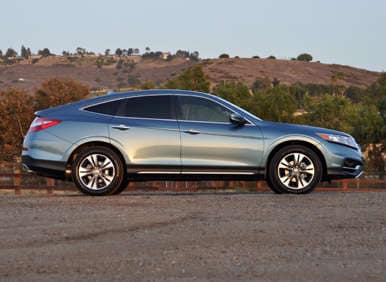Recent Articles
Popular Makes
Body Types
2013 Honda Crosstour Road Test and Review
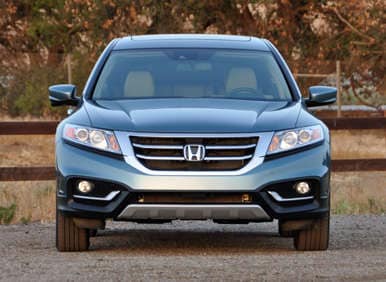
One might assume that if you take the hugely successful Honda Accord and turn it into a midsize crossover SUV to compete in one of the hottest segments in the market, the result would be truckloads of cash deposited into the automaker’s bank account as though the company were a single-ticket Powerball winner. Slotted between the Honda CR-V and the Honda Pilot and equipped with one of the most accurately descriptive names affixed to any vehicle, the Honda Crosstour must have been considered a slam-dunk from day one.
Until, that is, someone apparently said: “Just don’t make it look like a station wagon. People don’t buy station wagons.”*
And just like that, the Crosstour faced an insurmountable challenge. If a boxy butt was off the to-do list, but the Crosstour needed to offer extra cargo space, utility, and SUV styling cues when compared to the Accord Sedan, what was the solution? On the pages that follow, you’ll see the compromise that became the Crosstour, which is upgraded for 2013 but still isn’t the Subaru Outback killer that Honda must have envisioned during the vehicle’s gestation.
Oh, and for the record, in 2012, Honda sold 20,848 Crosstours, while Subaru moved 117,553 Outbacks.
* This is pure conjecture on the part of this review’s author. Previously, when the author asked about Honda’s fastback styling approach for the Crosstour, a company representative explained that because the Acura TSX lineup offered a traditional wagon, Honda elected to try a different approach with the Crosstour.
2013 Honda Crosstour Road Test and Review: Models and Prices
When choosing a 2013 Honda Crosstour, buyers select between a 4-cylinder and a V-6 engine, and between EX and EX-L trim levels. The Crosstour’s base price starts at $28,060 for the EX with front-wheel drive, and rises to $35,820 for the EX-L V6 with all-wheel drive.
Adding a V-6 engine to the Crosstour EX costs $3,660, but it comes with a whole bunch of extra stuff. Upgrades include 18-inch aluminum wheels, a 4-way power adjustable front passenger’s seat, illuminated steering wheel controls, dual-zone automatic climate control, and Smart Entry keyless access with push-button starting. Additionally, the Crosstour EX V6 is equipped with HondaLink connectivity technology, SMS text messaging capability, an 8-inch information display screen, a multi-angle reversing camera, a LaneWatch system, and a premium touchscreen audio system with Pandora Internet radio compatibility.
Stick with the 4-cylinder engine, and you can upgrade to the Crosstour EX-L ($31,745). This version of the car features most of the same equipment as the EX V6, plus a leather-wrapped steering wheel and shift knob, leather seats, heated front seats, and a 10-way power driver’s seat with memory settings. Additionally, the EX-L includes a lane departure warning system and a forward collision warning system, while the EX-L V6 ($34,370) has a universal garage door opener as standard equipment.
A hard disc drive navigation system with voice recognition technology is optional for the EX-L 4-cylinder and EX-L V6, adding $2,100 to the car’s window sticker. Packaged with the navigation system are real-time traffic reports and 16-GB of music storage accessed using a Song By Voice system.
To obtain all-wheel drive, it is necessary to select the top-of-the-line Crosstour EX-L with a V-6 engine, which is seen in the accompanying photos. My test car also included the optional navigation system, and cost $37,920, including the $830 destination charge.
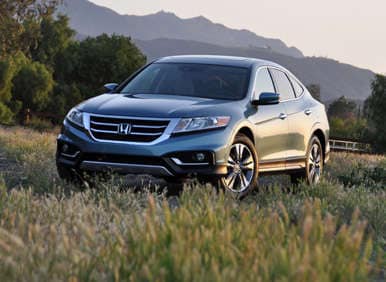
2013 Honda Crosstour Road Test and Review: Design
- Restyled exterior
- Upgraded interior
- New wheel designs
- Kona Coffee and Mountain Air paint colors
Do you like the color of the car seen in these pictures? That’s Mountain Air Metallic, a new Crosstour hue for 2013. You might also notice that the Crosstour has been given a significant facelift that, in my opinion, makes the car much more appealing than it used to be.
That does not mean, however, that I find the Crosstour appealing. Back in 2008, when spy photos of the Crosstour showed a wagon body style that promised a direct competitor to the Subaru Outback, I figured the Crosstour would be a can’t-miss hit. Then it arrived looking like a football on wheels. Fastback styling hasn’t worked for BMW (yet – they keep trying), and it’s not working for this Honda.
Inside, the Crosstour looks terrific. The tiered dashboard is the same as the one from the previous-generation Accord, but is jazzed up with trendy dark simulated wood trim and convincing simulated metallic accents. My test car’s two-tone cabin treatment and soft leather seats lent the Crosstour an upscale, luxurious look and feel, and the cargo area, compromised as it might be, was beautifully dressed with Berber-style carpeting. The only flaw worth mentioning is the black, glossy, plastic center console storage lid release, which looks like a part one might find in a decade-old Kia.
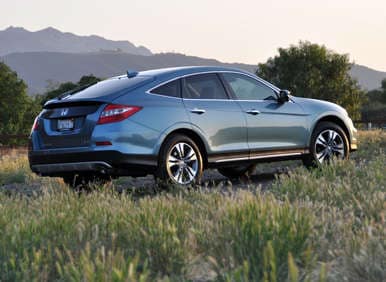
2013 Honda Crosstour Road Test and Review: Comfort and Cargo
- No changes for 2013
Comfortable front seats greet the Crosstour’s driver and front passenger, and while this car continues to use the previous-generation Accord interior design, my test car’s cabin appeared to be a cut above the old Accord in terms of fit, finish, and quality. It sure would be nice, however, if the Crosstour EX-L included a 6-way or 8-way power adjustable front passenger’s seat, instead of a simpler 4-way adjustment.
The Crosstour’s rear seat is spacious and comfortable, with plenty of leg and foot room, and a tall, supportive, plush bottom seat cushion. The seatback angle is a little bit too reclined for my tastes, but this is not really an issue. With the Crosstour’s dark tinted privacy glass, soft center armrest, and generous space, an adult can ride in comfort for hours.
Beautifully finished, the Crosstour’s 25.7 cu.-ft. cargo area is lined with Berber-style carpeting, and three storage bins located under the cargo floor add practicality to the vehicle. The center bin is huge, and constructed of plastic, making it good for storing wet items. Substantial levers located on both sides of the cargo area are used to fold the rear seatbacks with one hand, and to create 51.3 cu.-ft. of cargo space.
The Crosstour’s fastback roofline definitely cuts into the vehicle’s potential utility. I had trouble getting a full-size stroller into this car’s cargo area, trying several times to figure out the best way to make it fit (turns out, it’s not the easiest way). The sloped tailgate’s split glass window, large rear roof pillars, and tall rear seatbacks also compromise the view out.
In my opinion, the Crosstour would be all kinds of awesome if it had a wagon-style back end, like an Outback. My bet is that Honda would sell a whole bunch more of them.
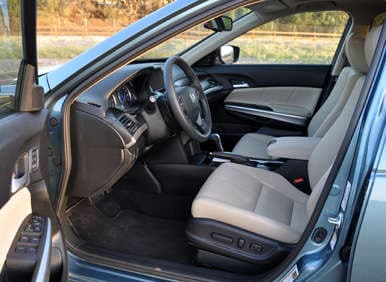
2013 Honda Crosstour Road Test and Review: Features and Controls
- Redesigned steering wheel
- Standard Bluetooth calling and music streaming
- Optional 8-inch information display screen
- Optional HondaLink smartphone pairing technology
- Optional SMS text messaging capability
- Optional Pandora Internet radio access
- Optional Smart Entry keyless entry and push-button ignition
For 2013, the Honda Crosstour gets a new steering wheel, a revised center stack layout, and increased storage space. These changes, in combination with a more refined approach to the car’s décor, give this Honda a simpler and more upscale look and feel.
My well-equipped Crosstour EX-L V6 test vehicle included Honda’s new touchscreen radio and 8-inch information display with remote control knob and function buttons. Pairing a smartphone to the system is easy, and the touchscreen radio offers an uncluttered display, large touch-sensitive buttons, and intuitive operation. Similarly, the big center control knob for the 8-inch information screen is simple and intuitive to use, and the surrounding buttons used to call up specific menus are large and marked with enormous letters.
Like most Hondas it is easy to get into a Crosstour, locate everything, and figure out how it works. In a technology driven world, this might be one of the greatest luxuries of all.
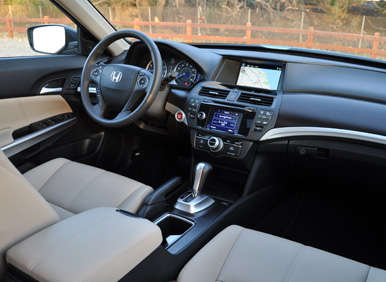
2013 Honda Crosstour Road Test and Review: Safety and Ratings
- Standard reversing camera
- Standard expanded-view driver’s side mirror
- Optional SMS text messaging capability
- Optional multi-view reversing camera
- Optional LaneWatch blind spot information system
- Optional lane departure warning system
- Optional forward collision warning system
If there’s any reason to upgrade from a basic Crosstour EX, its that key safety enhancements are offered on all versions of the vehicle except for the EX 4-cylinder. Granted, the new standard reversing camera and expanded-view driver’s side mirror are included on all models, but choose a more expensive variant, and you’ll get SMS text messaging capability, a multi-view reversing camera, a lane departure warning system, a forward collision warning system, and a LaneWatch blind spot information system.
With regard to LaneWatch, my wife pointed out that she prefers a blind-spot information system that offers an audible alert and a visual warning on or near the rearview mirror, which is where she’s already looking when such a system is most useful. With LaneWatch, she says, she finds herself distracted by cross-referencing two sources of information: the right side mirror, and the center in-dash screen. Plus, she criticizes, LaneWatch works only for the right side of the car.
I understand what she’s saying about LaneWatch. But I also think that Honda Crosstour owners can benefit from referencing two sources of information, or can retrain themselves to use the LaneWatch screen while changing lanes, which is why I called the technology “useful” in a Honda Accord review published earlier this year. This time around, I found that I ignored the LaneWatch display and only referenced the mirrors, wishing that LaneWatch worked on both sides of the Crosstour and offered visual warnings on the mirror or its housing. That makes the love of my life right in her opinion of LaneWatch.
Don’t tell her I said that.
Also, I found that the forward collision warning system proved sensitive in Los Angeles traffic, and the lane departure warning system misidentified a seam between blacktop and a concrete rain gutter as a lane marking. Together, while traveling in heavy traffic on a multi-lane highway, the system emitted audible warnings often enough that I tuned them out to some degree.
According to the Insurance Institute for Highway Safety (IIHS), the 2013 Honda Crosstour is a “Top Safety Pick.” The NHTSA has not performed crash tests on the Crosstour as this review is written.
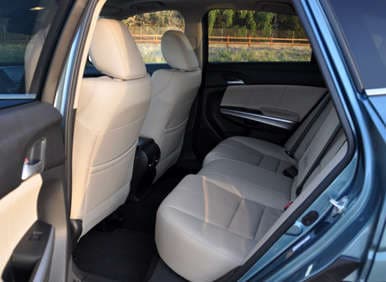
2013 Honda Crosstour Road Test and Review: Engines and Fuel Economy
- More powerful 3.5-liter V-6 engine
- Variable Cylinder Management added for V-6 engine
- New 6-speed automatic transmission for V-6 engine
The 2013 Honda Crosstour is equipped with a standard 192-horsepower, 2.4-liter 4-cylinder engine paired with a 5-speed automatic transmission and front-wheel drive. This is not one of Honda’s new “Earth Dreams” engines, carried over as it is from years past.
The Crosstour’s “Earth Dreams” 3.5-liter V-6 is new, developing 278 horsepower and 252 lb.-ft. of torque. With more horsepower, a broader torque curve, and a new 6-speed automatic transmission with paddle shifters, the Crosstour V6 feels livelier than before. Its also more fuel efficient, thanks to Variable Cylinder Management (VCM) technology, which shuts down half of the engine’s six cylinders under low load conditions in order to conserve fuel.
According to the EPA, my Crosstour V6 with all-wheel drive should have returned 19 mpg in the city, 28 mpg on the highway, and 22 mpg in combined driving. I averaged 23.7 mpg during a week of driving, and after covering more than 200 miles, the fuel gauge still indicated half a tank of gas. Also, note that the powerful Crosstour’s gas mileage performance fell short of the Honda Fit I recently tested by only 6.2 mpg.
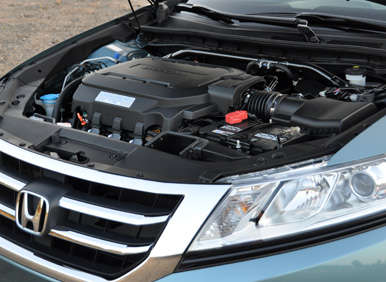
2013 Honda Crosstour Road Test and Review: Driving Impressions
There is no shortage of power with a Crosstour V6. This is a refined, energetic engine that sounds terrific when revved, and the driver cannot tell when the VCM technology engages and disengages. Unfortunately, it seems the 6-speed automatic transmission could stand further tuning.
On my test drive, when climbing switchbacks on a mountain road, the Crosstour’s transmission occasionally behaved as though it was confused about what it should be doing. In Sport mode, when exiting a couple of tight right-hand corners, the transmission caused the car to lunge forward with unexpected alacrity. Also in Sport mode, the transmission tended to hold revs too long, and to downshift too soon, making the car more difficult to drive smoothly. If you’re going to shift a Crosstour into “S,” plan to use the paddle shifters. It is a much more gratifying experience.
When in “D,” the transmission works in a more intuitive manner, upshifting rapidly when driving around town in order to conserve fuel, but sensing when the driver wants more power for accelerating away from an intersection or passing other traffic and holding gears appropriately. The transmission delivers fast, seamless upshifts, and never draws undue attention to itself in “D” mode.
Like nearly all Hondas, the Crosstour feels athletic from behind the steering wheel. The sophisticated 4-wheel independent suspension delivers a comfortable, yet taut, ride quality; the steering is light and direct; and the brake pedal is responsive and easy to modulate. Driven where, and how, most people drive, the Crosstour is fun, providing the proper levels of communication without beating anyone up in the process.
Take to a twisty road, however, and the handling falls apart. The nose-heavy Crosstour understeers at relatively low speeds, and I blame the lame 225/60 all-season tires. Plus, on a hot testing day, the brakes displayed fade relatively early. Of course, this vehicle is not designed for that type of driving, but with just a few changes, Honda could address these observations.
Back on the highway, the Crosstour’s comfort level, ride quality, and communication through the suspension and steering make this a great choice for a road trip. The cabin is quieter than the previous-generation Accord, but could use further isolation in terms of road rumble.
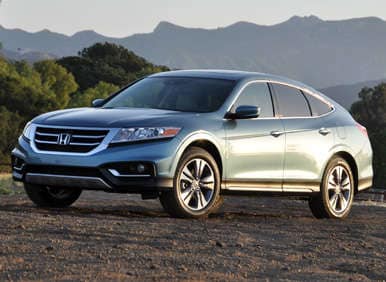
2013 Honda Crosstour Road Test and Review: Final Thoughts
If you like the way the 2013 Honda Crosstour looks, and you can live with its compromised cargo area, chances are that you’ll be very happy with this crossover SUV, and for many years to come if the reliability ratings in Consumer Reports are to be believed.
My advice to Honda, however, is this: don’t kill the Crosstour due to lackluster sales. There is potential greatness here. Instead, redesign the Crosstour using a successful, established formula.
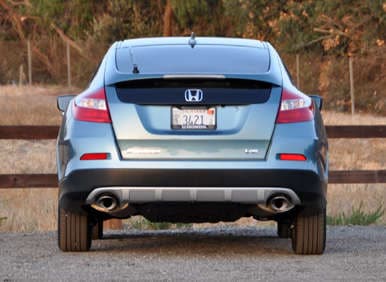
2013 Honda Crosstour Road Test and Review: Pros and Cons
- Compelling value equation
- Extremely comfortable seats
- Impressive interior materials and construction
- Speedy V-6 engine combined with decent fuel economy
- Fun to drive, most of the time
- Honda makes technology simple
- “Top Safety Pick” rating
- Strong reliability history
- Fastback roofline
- Compromised cargo space
- Low handling limits
- Questionable usefulness of LaneWatch system
Honda supplied the vehicle for this review
2013 Honda Crosstour EX-L V6 photos by Christian Wardlaw
